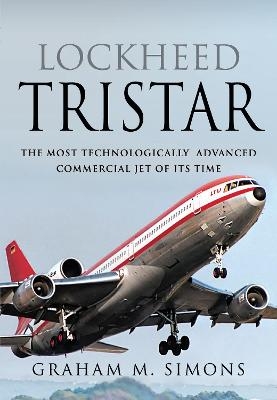
Lockheed TriStar
The Most Technologically Advanced Commercial Jet of Its Time
Seiten
2021
Air World (Verlag)
978-1-5267-5882-8 (ISBN)
Air World (Verlag)
978-1-5267-5882-8 (ISBN)
The Lockheed TriStar first flew in November 1970, with production continuing until 1984, by when some 250 aircraft had been built.
In April 1972, after six gruelling years of design and development, the then Lockheed California Company (now Lockheed Martin) delivered the most technologically advanced commercial jet of its era, the L-1011 TriStar, to its first client, Eastern Airlines.
To mark the moment, Lockheed decided to make an impressive statement about the capabilities of its new medium-to-long-range, wide-body trijet airliner. It did so in spectacular fashion. Overseen by two test pilots, a total of 115 crew members, VIPs, Lockheed employees, and selected reporters boarded a TriStar at Lockheed's Palmdale plant in California. The subsequent 4-hour, 13-minute flight to Washington Dulles Airport was achieved with virtually no input from the two pilots in the cockpit, the TriStar's Automatic Flight Control System being 'engaged from takeoff roll to landing'. It was, Lockheed proudly claimed, 'the first cross-country flight without the need for human hands on the controls'.
As Lockheed themselves note, in a similar fashion to other iconic passenger airliners before it, the L-1011 had faced daunting challenges on the way to its inaugural flight. Divergent needs from competing airlines led to design challenges. Financial difficulties ravaged its engine's manufacturer, Rolls-Royce, whilst a recession, fuelled by the world's first oil crisis, lessened the demand for commercial airliners.
Lockheed, though, battled through these challenges, which even included international allegations of bribery, with the result that the TriStar, famed for its large, curved nose, low-set wings, and graceful swept tail, remained in production until 1984, by when 250 examples had been built. The toll on Lockheed, however, was too great and after the TriStar it withdrew from the commercial aircraft business.
In this revealing insight into the L-1011, the renowned aviation historian Graham M. Simons reveals the full story of this airliner's design, development and service over the decades since 1970.
In April 1972, after six gruelling years of design and development, the then Lockheed California Company (now Lockheed Martin) delivered the most technologically advanced commercial jet of its era, the L-1011 TriStar, to its first client, Eastern Airlines.
To mark the moment, Lockheed decided to make an impressive statement about the capabilities of its new medium-to-long-range, wide-body trijet airliner. It did so in spectacular fashion. Overseen by two test pilots, a total of 115 crew members, VIPs, Lockheed employees, and selected reporters boarded a TriStar at Lockheed's Palmdale plant in California. The subsequent 4-hour, 13-minute flight to Washington Dulles Airport was achieved with virtually no input from the two pilots in the cockpit, the TriStar's Automatic Flight Control System being 'engaged from takeoff roll to landing'. It was, Lockheed proudly claimed, 'the first cross-country flight without the need for human hands on the controls'.
As Lockheed themselves note, in a similar fashion to other iconic passenger airliners before it, the L-1011 had faced daunting challenges on the way to its inaugural flight. Divergent needs from competing airlines led to design challenges. Financial difficulties ravaged its engine's manufacturer, Rolls-Royce, whilst a recession, fuelled by the world's first oil crisis, lessened the demand for commercial airliners.
Lockheed, though, battled through these challenges, which even included international allegations of bribery, with the result that the TriStar, famed for its large, curved nose, low-set wings, and graceful swept tail, remained in production until 1984, by when 250 examples had been built. The toll on Lockheed, however, was too great and after the TriStar it withdrew from the commercial aircraft business.
In this revealing insight into the L-1011, the renowned aviation historian Graham M. Simons reveals the full story of this airliner's design, development and service over the decades since 1970.
GRAHAM M. SIMONS was one of the founders of the world-famous aviation museum at Duxford near Cambridge where his interest was piqued watching the making of the film Battle of Britain there in the late 1960s. From this, and with an engineering background, he progressed to membership of a number of aviation societies, including sitting on the British Aviation Preservation Council, eventually taking the position of Engineering Director with one group. Graham combines his love of writing with his skills in production to create and publish aviation histories focused on a variety of subjects.
| Erscheinungsdatum | 01.12.2021 |
|---|---|
| Zusatzinfo | 175 colour illustrations |
| Verlagsort | Barnsley |
| Sprache | englisch |
| Maße | 172 x 246 mm |
| Themenwelt | Natur / Technik ► Fahrzeuge / Flugzeuge / Schiffe ► Luftfahrt / Raumfahrt |
| Technik ► Fahrzeugbau / Schiffbau | |
| Technik ► Luft- / Raumfahrttechnik | |
| ISBN-10 | 1-5267-5882-2 / 1526758822 |
| ISBN-13 | 978-1-5267-5882-8 / 9781526758828 |
| Zustand | Neuware |
| Informationen gemäß Produktsicherheitsverordnung (GPSR) | |
| Haben Sie eine Frage zum Produkt? |
Mehr entdecken
aus dem Bereich
aus dem Bereich
Schulbuch Klassen 7/8 (G9)
Buch | Hardcover (2015)
Klett (Verlag)
31,50 €
Buch | Softcover (2004)
Cornelsen Verlag
25,99 €


